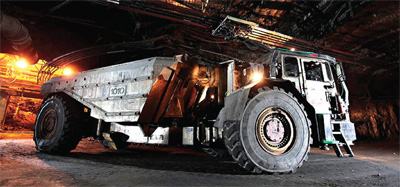 The Vale fleet of Kiruna haul trucks at Coleman Mine in Sudbury is transitioning to an AC electric system. Unlike the older DC-powered trucks that use battery power for tramming off the trolley line, the new AC model boasts a four-cylinder diesel engine that runs a generator to produce electricity.
The Vale fleet of Kiruna haul trucks at Coleman Mine in Sudbury is transitioning to an AC electric system. Unlike the older DC-powered trucks that use battery power for tramming off the trolley line, the new AC model boasts a four-cylinder diesel engine that runs a generator to produce electricity.
The DC trucks switch to battery power for loading and dumping and are able to operate off the trolley line for approximately 20 minutes. The AC model “is a lot more powerful because it’s a diesel-electric drive,” said Darcy Boreham, service supervisor for ABB Canada. “You can drive this truck up a 16 per cent grade at two kilometres per hour (off the electric trolley line), so you’re not limited anymore.”Equipped with an 80-litre fuel tank, the truck can operate for five to six hours offline, allowing it to be used for development work if necessary.“The DC trucks run at 1,000 volts, while the AC trucks run at 690 volts, but because we need to run both trucks at Coleman, we put a transformer on the AC truck to take the voltage down,” said Boreham. “Once we get rid of the DC trucks we can get rid of the transformer, which is about two tonnes extra on the truck.”Coleman Mine has been using Kiruna trucks for 15 years and currently has four older, DC-powered models, one AC truck about to go into service following a year of testing, a sixth AC truck assembled and parked and a third one on order. “The plan is to complete the transition to AC at Coleman in five or six years,” said Boreham.Two more Kiruna trucks are at Vale’s Creighton Mine in Sudbury.
The only other Kirunas in North America are at the Stillwater Mining Company in Montana, which has two trucks and a third on order.
The trucks carry a 50-tonne payload and are able to tram fully loaded at speeds of up to 18 kilometres an hour up a 16 per cent grade, compared to eight or nine kilometres and hour for a conventional diesel truck, said Coleman Mine’s Fred Pelletier, who oversees Kiruna logistics.
The trucks receive power from a series of overhead trolley lines extending eight kilometres and serving several levels of the mine. The trucks decouple from the line for loading, dumping and entering the service bay.
According to Boreham, Kirunas are ideal for ramp access mines with orebodies in different areas and long tramming distances. The faster tramming speeds allow one Kiruna truck to move as much ore as several conventional diesel trucks. Another benefit is the absence of diesel exhaust and the saving on ventilation costs.
The Kiruna trucks run on a smooth multi-layered roadbed treated with PetroTac, an emulsified tar product, and swept regularly to collect dust and debris.
“The roadbed needs to be as smooth as possible because the power is coming from a collector arm, so the less jolting, the better,” said Pelletier.
Drivers like the trucks because they are quieter and smoother running than diesel trucks.
Traffic is managed on a dedicated radio channel monitored by the drivers. Mine personnel entering the Kiruna ramp use the radio to report their location and find out where the trucks are before proceeding.
Tougher emission laws and the rising cost of ventilation could lead to more interest in Kiruna technology, but mine layout will also dictate their feasibility.
Gia Industri of Sweden fabricates the mechanical part of the truck, including the axles and frame, while ABB is responsible for the electrical components.


